中国文化概况 Chapter 7
- 格式:ppt
- 大小:5.55 MB
- 文档页数:59
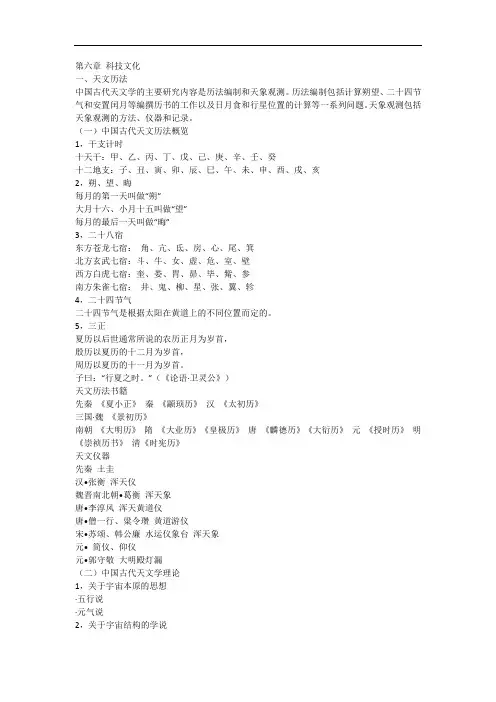
第六章科技文化一、天文历法中国古代天文学的主要研究内容是历法编制和天象观测。
历法编制包括计算朔望、二十四节气和安置闰月等编撰历书的工作以及日月食和行星位置的计算等一系列问题。
天象观测包括天象观测的方法、仪器和记录。
(一)中国古代天文历法概览1,干支计时十天干:甲、乙、丙、丁、戊、己、庚、辛、壬、癸十二地支:子、丑、寅、卯、辰、巳、午、未、申、酉、戌、亥2,朔、望、晦每月的第一天叫做“朔”大月十六、小月十五叫做“望”每月的最后一天叫做“晦”3,二十八宿东方苍龙七宿:角、亢、氐、房、心、尾、箕北方玄武七宿:斗、牛、女、虚、危、室、壁西方白虎七宿:奎、娄、胃、昴、毕、觜、参南方朱雀七宿:井、鬼、柳、星、张、翼、轸4,二十四节气二十四节气是根据太阳在黄道上的不同位置而定的。
5,三正夏历以后世通常所说的农历正月为岁首,殷历以夏历的十二月为岁首,周历以夏历的十一月为岁首。
子曰:“行夏之时。
”(《论语·卫灵公》)天文历法书籍先秦《夏小正》秦《颛顼历》汉《太初历》三国·魏《景初历》南朝《大明历》隋《大业历》《皇极历》唐《麟德历》《大衍历》元《授时历》明《崇祯历书》清《时宪历》天文仪器先秦土圭汉•张衡浑天仪魏晋南北朝•葛衡浑天象唐•李淳风浑天黄道仪唐•僧一行、粱令瓒黄道游仪宋•苏颂、韩公廉水运仪象台浑天象元• 简仪、仰仪元•郭守敬大明殿灯漏(二)中国古代天文学理论1,关于宇宙本原的思想·五行说·元气说2,关于宇宙结构的学说盖天说浑天说宣夜说3,关于宇宙无限性的辩证论述宇:空间宙:时间(三)中国古代天文学的特征1,中国古代的天象记录是当时世界上最丰富,最有系统的。
日食月食、日珥、流星雨、哈雷彗星、太阳黑子、新星(客星)、超新星、蟹状星云、行星、恒星……2、历法的编纂带动天文学的发展,以阴阳合历为传统,并与农业关系密切。
3,中国古代天文学明显的官办色彩,与占星术密切相关。
二、传统医学(一)中国传统医药概览1,砭石与灸法砭石是原始人类最初使用的医疗工具灸法产生于火的发现和使用之后。
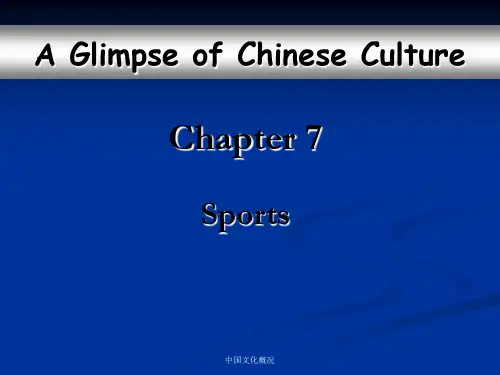
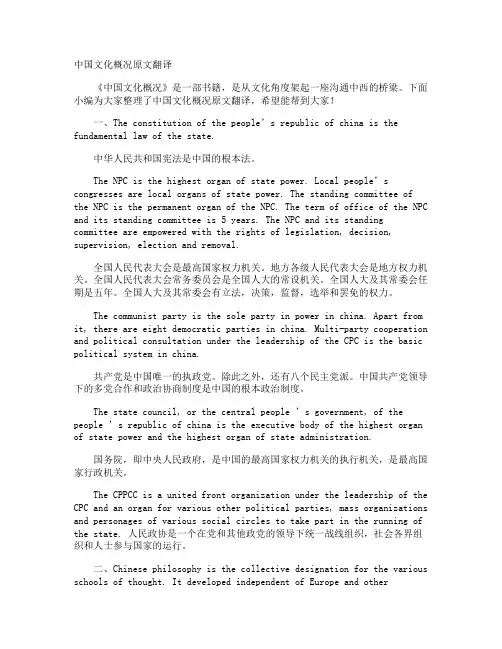
中国文化概况原文翻译《中国文化概况》是一部书籍,是从文化角度架起一座沟通中西的桥梁。
下面小编为大家整理了中国文化概况原文翻译,希望能帮到大家!一、The constitution of the people’s republic of china is the fundamental law of the state.中华人民共和国宪法是中国的根本法。
The NPC is the highest organ of state power. Local people’s congresses are local organs of state power. The standing committee of the NPC is the permanent organ of the NPC. The term of office of the NPC and its standing committee is 5 years. The NPC and its standing committee are empowered with the rights of legislation, decision, supervision, election and removal.全国人民代表大会是最高国家权力机关。
地方各级人民代表大会是地方权力机关。
全国人民代表大会常务委员会是全国人大的常设机关。
全国人大及其常委会任期是五年。
全国人大及其常委会有立法,决策,监督,选举和罢免的权力。
The communist party is the sole party in power in china. Apart from it, there are eight democratic parties in china. Multi-party cooperation and political consultation under the leadership of the CPC is the basic political system in china.共产党是中国唯一的执政党。
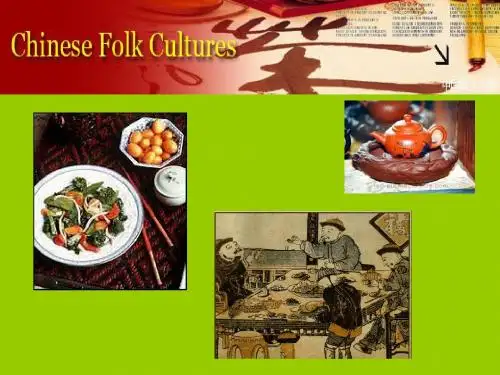
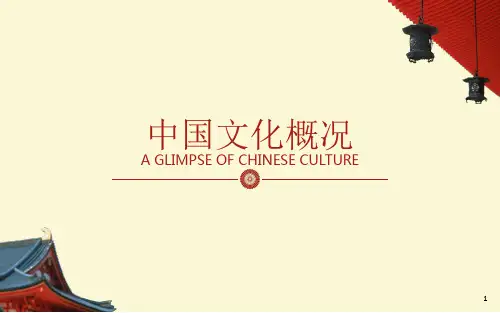
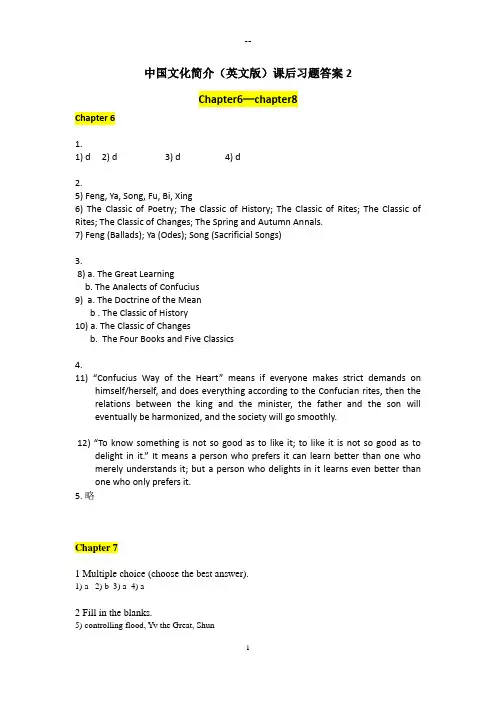
中国文化简介(英文版)课后习题答案2Chapter6—chapter8Chapter 61.1) d 2) d 3) d 4) d2.5) Feng, Ya, Song, Fu, Bi, Xing6) The Classic of Poetry; The Classic of History; The Classic of Rites; The Classic of Rites; The Classic of Changes; The Spring and Autumn Annals.7) Feng (Ballads); Ya (Odes); Song (Sacrificial Songs)3.8) a. The Great Learningb. The Analects of Confucius9) a. The Doctrine of the Meanb . The Classic of History10) a. The Classic of Changesb. The Four Books and Five Classics4.11) “Confucius Way of the Heart”means if everyone makes strict demands onhimself/herself, and does everything according to the Confucian rites, then the relations between the king and the minister, the father and the son will eventually be harmonized, and the society will go smoothly.12) “To know something is not so good as to like it; to like it is not so good as todelight in it.” It means a person who prefers it can learn better than one who merely understands it; but a person who delights in it learns even better than one who only prefers it.5. 略Chapter 71 Multiple choice (choose the best answer).1) a 2) b 3) a 4) a2 Fill in the blanks.5)controlling flood, Yv the Great, Shun6)Pan Gu, Nv Wa, her own model, yellow clay3 Translate the following terms into English7)a. the descendants of Yan and Huang b. Yv the Great controlling the flood8)a. the Eight Immortals crossing the sea. b. Nv Wa creating man9)a. Pan Gu creating the world b.Kua Fu chasing the Sun4 Answer the following questions.10)Huang Di is resourceful in invention as well as in war and is credited with the invention of many things, like carts and boats, clothes, houses, writing and silkworm breeding and Silk weaving. Yan Di is credited with the invention of farming and medicine. He invented the wooden plow and taught people how to treat diseases. Wars urged the mixture and the assimilation of different tribes and eventually formed a tribal alliance of Huang Di and Yan Di. Traditions has it that Chinese civilization originated from the era of Huang Di and Yan Di, for they are the ancestors of the Chinese people. That is why the Chinese call themselves the descendants of Yan and Huang.11)略5 Retell the stories with the help of the following pictures.略Chapter 81.1) a 2)d 3)d 4) a2.5) the guti verse forms, jinti verse forms, classical, verse form, moder6) Shijing7) Li Sao8) Sage Poet, the greatest realist poet9) Su Shi, Li Qingzhao3.10) a. Tang Poems b. Songci11) a. yuanqu b. Chuci4.12) Yuefu originally referred to the “music bureau” in the Han Dynasty, responsible for collecting or writing poems, folk songs and ballads, and having them set to music. Later, poems, folk songs and ballads collected and compiled by yufu were given the name Yuefu.13) Ci is a kind of poetry written to certain tunes with strict tonal patterns and rhyme schemes, in fixed numbers of lines and words, originated in Tang Dynasty and fully developed in Song Dynasty.14) Apart from the above verse forms, there is also Fu, it’s something between poetry and prose, similar to rhapsody: a descriptive poem, and much cultivated from Han times to the Six Dynasties. Examples are Su Shi's “Fu on the Red Cliff”, Ban Gu’s Rhapsody on Two Capitals”, etc.5. 略。
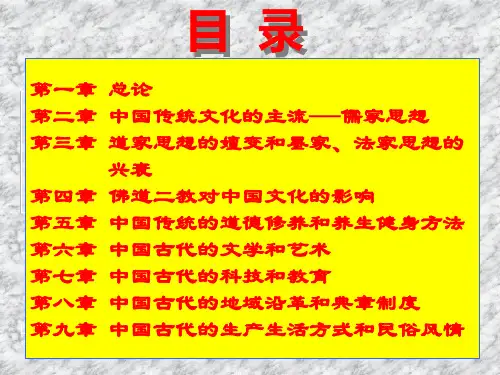

中国文化概况中国文化概况1.天何言哉?四时行焉,百草生焉,天何言哉?Heaven does not speak in words. It speaks through the rotation of the four seasons and the growth of all living things.2.生生之谓易。
Continuous creation of life is change.3.天地之大德曰生。
The great virtue of Heaven and Earth is creating life.4.获罪于天,无所祷也。
He who offends against Heaven has none to whom he can pray.5.仁者,人也,亲亲为大。
The greatest love for people is the love for one’s parents.6.父母在,不远游,游必有方。
Children should not travel far while their parents are alive. If they have no choice but to do so, they must retain some restraint.7.父母之年,不可不知也。
一则以喜,一则以惧。
Children should think often of the age of their parents. They should feel feel happy for the healthy and longevity of their parents. They should also feel concern for the aging of their parents.8.己欲立而立人,己欲达而达人。
While fulfilling one’s own desires, allow others to fulfill theirs.9.己所不欲,勿施于人。
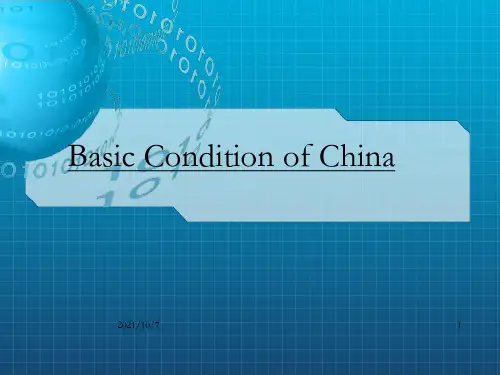

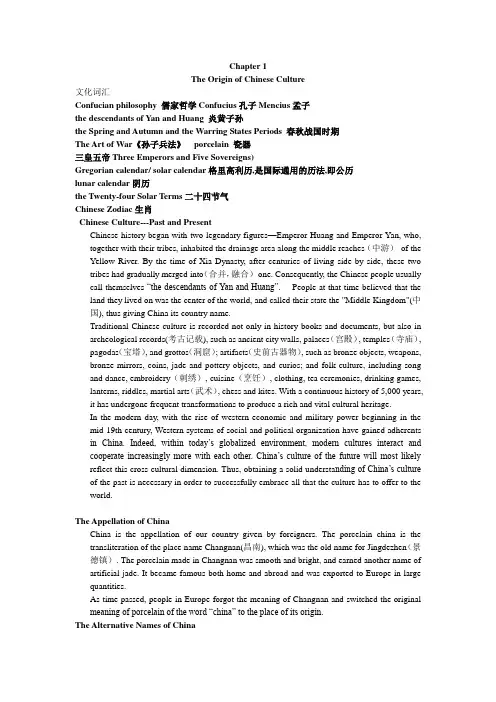
Chapter 1The Origin of Chinese Culture文化词汇Confucian philosophy 儒家哲学Confucius孔子Mencius孟子the descendants of Y an and Huang 炎黄子孙the Spring and Autumn and the Warring States Periods 春秋战国时期The Art of War《孙子兵法》porcelain 瓷器三皇五帝Three Emperors and Five Sovereigns)Gregorian calendar/ solar calendar格里高利历,是国际通用的历法,即公历lunar calendar阴历the Twenty-four Solar Terms二十四节气Chinese Zodiac生肖Chinese Culture---Past and PresentChinese history began with two legendary figures—Emperor Huang and Emperor Yan, who, together with their tribes, inhabited the drainage area along the middle reaches(中游)of the Yellow River. By the time of Xia Dynasty, after centuries of living side by side, these two tribes had gradually merged into(合并,融合)one. Consequently, the Chinese people usually call themselves “the descendants of Yan and Huang”.People at that time believed that the land they lived on was the center of the world, and called their state the "Middle Kingdom"(中国), thus giving China its country name.Traditional Chinese culture is recorded not only in history books and documents, but also in archeological records(考古记载), such as ancient city walls, palaces(宫殿), temples(寺庙), pagodas(宝塔), and grottos(洞窟); artifacts(史前古器物), such as bronze objects, weapons, bronze mirrors, coins, jade and pottery objects, and curios; and folk culture, including song and dance, embroidery(刺绣), cuisine(烹饪), clothing, tea ceremonies, drinking games, lanterns, riddles, martial arts(武术), chess and kites. With a continuous history of 5,000 years, it has undergone frequent transformations to produce a rich and vital cultural heritage.In the modern day, with the rise of western economic and military power beginning in the mid-19th century, Western systems of social and political organization have gained adherents in China. Indeed, within today’s globalized environment, modern cultures interact and cooperate increasingly more with each other. China’s culture of the future will most likely reflect this cross-cultural dimension. Thus, obtaining a solid understa nding of China’s culture of the past is necessary in order to successfully embrace all that the culture has to offer to the world.The Appellation of ChinaChina is the appellation of our country given by foreigners. The porcelain china is the transliteration of the place name Changnan(昌南), which was the old name for Jingdezhen(景德镇). The porcelain made in Changnan was smooth and bright, and earned another name of artificial jade. It became famous both home and abroad and was exported to Europe in large quantities.As time passed, people in Europe forgot the meaning of Changnan and switched the original meaning of porcelain of the word “china” to the place of its origin.The Alternative Names of China⏹Chixian, Shenzhou(赤县、神州)⏹Jiuzhou (九州)⏹Hua ( 华)⏹Huaxia(华夏)⏹Zhonghua(中华)⏹Hainei(海内)Chinese MythologyChinese Mythology is a collection of cultural history, folktales(民间故事), and religions that have been passed down in oral or written form. Chinese mythology is similar to modern religion in that they both believe in relationships between mankind and a higher power.Historians have conjectured(推测)that Chinese mythology began in 12th century BC (close to the time of the Trojan War 特洛伊战争). The myths and legends were passed down in oral form for over a thousand years, before being written down in early book such as Shui Jing Zhu and Shan Hai Jing.The classification of myth神话的分类Creation myth 创世神话:Nvwa Created Man(女娲造人)Hero myth 英雄神话:Houyi Shooting the Sun(后羿射日)War myth 战争神话:Yellow Emperor Tackled Human-God(黄帝擒蚩尤)Cultural MosaicHeavenly Stems and Earthly BranchesThe standard Gregorian calendar is generally referred to as the solar calendar in China. The traditional Chinese lunar calendar, also known as the Jiazi calendar, counts the years in sixty-year cycles by combining two series of numbers---the 10 Heavenly Stems and 12 Earthly Branches.The Twenty-four Solar TermsThe traditional Chinese lunar year is divided into twenty-four solar terms, according to the position of the sun on the ecliptic in relationship to the earth. The solar terms designate agricultural periods, and can predict changing seasonal conditions, temperature, and weather throughout the course of the year. They are extremely important to agricultural production.Changes in the four seasons are determined by eight solar terms:立春( the Beginning of Spring),春分( the Spring Equinox ),立夏(the Beginning of Summer ),夏至(the Summer Solstice),立秋(the Beginning of Autumn),秋分( the Autumnal Equinox),立冬( the Beginning of Winter),冬至(the Winter Solstice )Changes in temperature are indicated by five solar terms:小暑Slight Heat ,大暑Great Heat ,处暑the Limit of Heat ,小寒Slight Cold ,大寒Great ColdChanging weather conditions are indicated by seven solar terms:雨水Rain Water ,谷雨Grain Rain ,白露White Dew ,寒露Cold Dew,霜降Frost's Descent ,小雪Slight Snow ,大雪Great Snow .Recurring natural phenomena are indicated by four solar terms:惊蛰the Waking of Insects ,清明Pure Brightness ,小满Grain Full,芒种Grain in EarChinese ZodiacIn ancient times, our ancestors counted the years with 10 heavenly stems and 12 earthly branches. Although this was scientific, most people were illiterate and could not memorize or calculate easily. Thus the animals that influenced people's lives were chosen to symbolize the terrestrial branches: the rat, ox, tiger, rabbit, dragon, snake, horse, sheep, monkey , rooster, dog and pig.Chapter 2 Culinary Culture文化词汇culinary厨房的,烹饪的;烹调用的cuisine烹饪,烹调法;菜肴main food主食,主粮(staple food )Fire temperature火候food tonic 食补“Food is the first necessity of the people”(“民以食为天。
Chapter 1The Origin of Chinese Culture文化词汇Confucian philosophy 儒家哲学Confucius孔子Mencius孟子the descendants of Yan and Huang 炎黄子孙the Spring and Autumn and the Warring States Periods 春秋战国时期The Art of War《孙子兵法》porcelain 瓷器三皇五帝Three Emperors and Five Sovereigns)Gregorian calendar/ solar calendar格里高利历,是国际通用的历法,即公历lunar calendar阴历the Twenty-four Solar Terms二十四节气Chinese Zodiac生肖Chinese Culture---Past and PresentChinese history began with two legendary figures—Emperor Huang and Emperor Yan, who, together with their tribes, inhabited the drainage area along the middle reaches(中游)of the Yellow River. By the time of Xia Dynasty, after centuries of living side by side, these two tribes had gradually merged into(合并,融合)one. Consequently, the Chinese people usually call themselves “the descendants of Yan and Huang”.People at that time believed that the land they lived on was the center of the world, and called their state the "Middle Kingdom"(中国), thus giving China its country name.Traditional Chinese culture is recorded not only in history books and documents, but also in archeological records(考古记载), such as ancient city walls, palaces(宫殿), temples(寺庙), pagodas(宝塔), and grottos(洞窟); artifacts(史前古器物), such as bronze objects, weapons, bronze mirrors, coins, jade and pottery objects, and curios; and folk culture, including song and dance, embroidery(刺绣), cuisine(烹饪), clothing, tea ceremonies, drinking games, lanterns, riddles, martial arts(武术), chess and kites. With a continuous history of 5,000 years, it has undergone frequent transformations to produce a rich and vital cultural heritage.In the modern day, with the rise of western economic and military power beginning in the mid-19th century, Western systems of social and political organization have gained adherents in China. Indeed, within today’s globalized environment, modern cultures interact and cooperate increasingly more with each other. China’s culture of the future will most likely reflect this cross-cultural dimension. Thus, obtaining a solid understanding of China’s culture of the past is necessary in order to successfully embrace all that the culture has to offer to the world.The Appellation of ChinaChina is the appellation of our country given by foreigners. The porcelain china is the transliteration of the place name Changnan(昌南), which was the old name for Jingdezhen(景德镇). The porcelain made in Changnan was smooth and bright, and earned another name of artificial jade. It became famous both home and abroad and was exported to Europe in large quantities.As time passed, people in Europe forgot the meaning of Changnan and switched the original meaning of porcelain of the word “china” to the place of its origin.The Alternative Names of China⏹Chixian, Shenzhou(赤县、神州)⏹Jiuzhou (九州)⏹Hua ( 华)⏹Huaxia(华夏)⏹Zhonghua(中华)⏹Hainei(海内)Chinese MythologyChinese Mythology is a collection of cultural history, folktales(民间故事), and religions that have been passed down in oral or written form. Chinese mythology is similar to modern religion in that they both believe in relationships between mankind and a higher power.Historians have conjectured(推测)that Chinese mythology began in 12th century BC (close to the time of the Trojan War 特洛伊战争). The myths and legends were passed down in oral form for over a thousand years, before being written down in early book such as Shui Jing Zhu and Shan Hai Jing.The classification of myth神话的分类Creation myth 创世神话:Nvwa Created Man(女娲造人)Hero myth 英雄神话:Houyi Shooting the Sun(后羿射日)War myth 战争神话:Yellow Emperor Tackled Human-God(黄帝擒蚩尤)Cultural MosaicHeavenly Stems and Earthly BranchesThe standard Gregorian calendar is generally referred to as the solar calendar in China. The traditional Chinese lunar calendar, also known as the Jiazi calendar, counts the years in sixty-year cycles by combining two series of numbers---the 10 Heavenly Stems and 12 Earthly Branches.The Twenty-four Solar TermsThe traditional Chinese lunar year is divided into twenty-four solar terms, according to the position of the sun on the ecliptic in relationship to the earth. The solar terms designate agricultural periods, and can predict changing seasonal conditions, temperature, and weather throughout the course of the year. They are extremely important to agricultural production.Changes in the four seasons are determined by eight solar terms:立春( the Beginning of Spring),春分( the Spring Equinox ),立夏(the Beginning of Summer ),夏至(the Summer Solstice),立秋(the Beginning of Autumn),秋分( the Autumnal Equinox),立冬( the Beginning of Winter),冬至(the Winter Solstice )Changes in temperature are indicated by five solar terms:小暑Slight Heat ,大暑Great Heat ,处暑the Limit of Heat ,小寒Slight Cold ,大寒Great ColdChanging weather conditions are indicated by seven solar terms:雨水Rain Water ,谷雨Grain Rain ,白露White Dew ,寒露Cold Dew,霜降Frost's Descent ,小雪Slight Snow ,大雪Great Snow .Recurring natural phenomena are indicated by four solar terms:惊蛰the Waking of Insects ,清明Pure Brightness ,小满Grain Full,芒种Grain in EarChinese ZodiacIn ancient times, our ancestors counted the years with 10 heavenly stems and 12 earthly branches. Although this was scientific, most people were illiterate and could not memorize or calculate easily. Thus the animals that influenced people's lives were chosen to symbolize the terrestrial branches: the rat, ox, tiger, rabbit, dragon, snake, horse, sheep, monkey , rooster, dog and pig.Chapter 2 Culinary Culture文化词汇culinary厨房的,烹饪的;烹调用的cuisine烹饪,烹调法;菜肴main food主食,主粮(staple food )Fire temperature火候food tonic 食补“Food is the first necessity of the people”(“民以食为天。
中国文化简介(英文版)课后习题答案2中国文化简介(英文版)课后习题答案2Chapter6—chapter8Chapter 61.1) d 2) d 3) d 4) d2.5) Feng, Ya, Song, Fu, Bi, Xing6) The Classic of Poetry; The Classic of History; The Classic of Rites; The Classic of Rites; The Classic of Changes; The Spring and Autumn Annals.7) Feng (Ballads); Ya (Odes); Song (Sacrificial Songs)3.8) a. The Great Learningb. The Analects of Confucius9) a. The Doctrine of the Meanb . The Classic of History10) a. The Classic of Changesb. The Four Books and Five Classics4.11) “Confucius Way of the Heart”means if everyone makes strict demands onhimself/herself, and does everything according to the Confucian rites, then the relations between the king and the minister, the father and the son will eventually be harmonized, and the society will go smoothly.12) “To know something is not so good as to like it; to like it is not so good as todelight in it.” It means a person who prefers it can learn better than one who merely understands it; but a person who delights in it learns even better than one who only prefers it.5. 略Chapter 71 Multiple choice (choose the best answer).1) a 2) b 3) a 4) a2 Fill in the blanks.5)controlling flood, Yv the Great, Shun6)Pan Gu, Nv Wa, her own model, yellow clay3 Translate the following terms into English7)a. the descendants of Yan and Huang b. Yv the Great controlling the flood8)a. the Eight Immortals crossing the sea. b. Nv Wa creating man9)a. Pan Gu creating the world b.Kua Fu chasing the Sun4 Answer the following questions.10)Huang Di is resourceful in invention as well as in war and is credited with the invention of many things, like carts and boats, clothes, houses, writing and silkworm breeding and Silk weaving. Yan Di is credited with the invention of farming and medicine. He invented the wooden plow and taught people how to treat diseases. Wars urged the mixture and the assimilation of different tribes and eventually formed a tribal alliance of Huang Di and Yan Di. Traditions has it that Chinese civilization originated from the era of Huang Di and Yan Di, for they are the ancestors of the Chinese people. That is why the Chinese call themselves the descendants of Yan and Huang.11)略5 Retell the stories with the help of the following pictures.略Chapter 81.1) a 2)d 3)d 4) a2.5) the guti verse forms, jinti verse forms, classical, verse form, moder6) Shijing7) Li Sao8) Sage Poet, the greatest realist poet9) Su Shi, Li Qingzhao3.10) a. Tang Poems b. Songci11) a. yuanqu b. Chuci4.12) Yuefu originally referred to the “music bureau” in the Han Dynasty, responsible for collecting or writing poems, folk songs and ballads, and having them set to music. Later, poems, folk songs and ballads collected and compiled by yufu were given the name Yuefu.13) Ci is a kind of poetry written to certain tunes with strict tonal patterns and rhyme schemes, in fixed numbers of lines and words, originated in Tang Dynasty and fully developed in Song Dynasty.14) Apart from the above verse forms, there is also Fu, it’s something between poetry and prose, similar to rhapsody: a descriptive poem, and much cultivated from Han times to the Six Dynasties. Examples are S u Shi's “Fu on the Red Cliff”, Ban Gu’s Rhapsody on Two Capitals”, etc.5. 略。
中国文化概况中英版An Overview of Chinese Culture (English Version)I. IntroductionChinese culture, with its long history and profound essence, is the sum of material and spiritual cultures created and passed down by the Chinese nation throughout its historical development. Chinese culture emphasizes humanism, focusing on moral values, etiquette, family, and social order.II. Main Contents1. History and EvolutionChinese culture boasts a rich history spanning thousands of years, from the Xia, Shang, and Zhou dynasties to the Spring and Autumn period, the Warring States period, and then to the Tang, Song, Yuan, Ming, and Qing dynasties. It has continuously absorbed and integrated foreign cultures, forming a unique cultural system.2. Traditional ValuesConfucianism is one of the cornerstones of Chinese culture, emphasizing virtues such as benevolence, filial piety, loyalty, and etiquette, which have profoundly influenced the behavior and values of the Chinese people. Taoism emphasizes the harmony between man and nature, advocating a natural and non-interventionist approach. Buddhism, on the other hand, emphasizes compassion and self-sacrifice, having a significant impact on Chinese religion and philosophy.3. Cultural Characteristics- Festival Culture: China has many traditional festivals, such as the Spring Festival, Mid-Autumn Festival, and Dragon Boat Festival, each with unique celebration methods and cultural connotations.- Clothing Culture: Traditional Chinese clothing, such as Hanfu and Tangzhuang, reflects the unique aesthetic concepts and cultural characteristics of the Chinese nation.- Architectural Culture: Traditional Chinese architecture, including palaces, temples, and gardens, is renowned for its distinctive styles and exquisite craftsmanship.- Cuisine Culture: Chinese cuisine, known for its rich flavors and exquisiteculinary techniques, is an important representation of China's cultural charm.4. Influence on the WorldThe values and ideological systems of Chinese culture have had a profound impact on the world, especially Confucianism, which has influenced Asia and beyond. Traditional Chinese arts and forms of expression, such as calligraphy, painting, and Peking Opera, are also deeply loved and admired by people around the world.III. ConclusionChinese culture is a treasure of the Chinese nation, embodying unique charm and value. Through learning and understanding Chinese culture, we can gain a deeper understanding of the history, traditions, and spiritual outlook of the Chinese people, further enhancing our sense of national pride and self-confidence. At the same time, Chinese culture has also made significant contributions to the diversity and development of world culture.中国文化概况中英版一、引言中国文化,源远流长,博大精深,是中华民族在长期历史发展过程中所创造并传承下来的物质文化和精神文化的总和。
中国文化概览译文(部分)
中国是世界上历史最悠久、影响最广泛的文明之一。
中国文化概览可以从以下几个方面来介绍:
1. 历史:中国文化的起源可以追溯到5,000年前的黄河流域,经历了数千年的发展和变迁。
中国历史可以分为各个朝代,其中最具有代表性的是汉朝、唐朝和清朝。
2. 语言:汉语是中国的官方语言,同时也是世界上使用人数最多的语言之一。
汉字是唯一的书写系统,拼音也是汉语拼写的助记符。
3. 宗教:中国主要宗教是佛教、道教和儒教。
佛教信仰强调人生苦旅和解脱,道教重视长寿和内功修行,儒教则强调礼仪、道德和社会责任。
4. 音乐:中国音乐源远流长,有着独特的音乐文化和乐器。
古代中文音乐曲调简单、节奏缓慢,主要使用管弦乐器和弹拨乐器。
5. 美食:中国美食有着丰富多样的特色,注重菜肴口味的调味和制作工艺。
中国菜以四川菜、广东菜、鲁菜等地方菜系为代表。
6. 绘画:中国绘画历史悠久,涵盖了山水、花鸟、人物等多个类型。
中国画的传统形式是水墨画,主要用于表现自然景观。
以上就是中国文化概览的一些主要内容,其中还包括了传统节日、服饰、建筑等多个方面,这些元素共同构成了中国丰富多彩的文化体系。